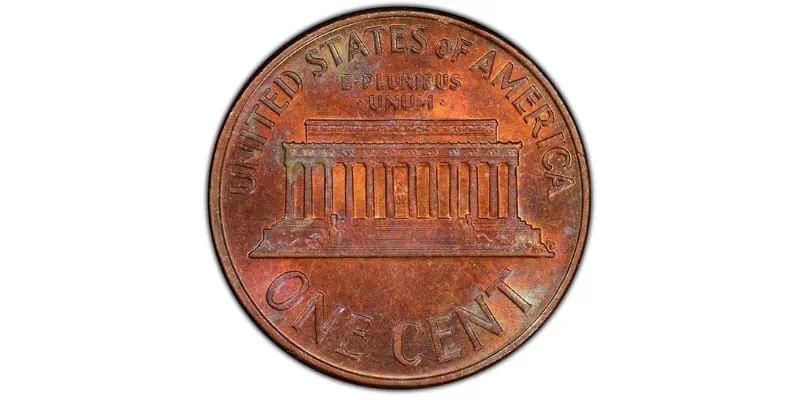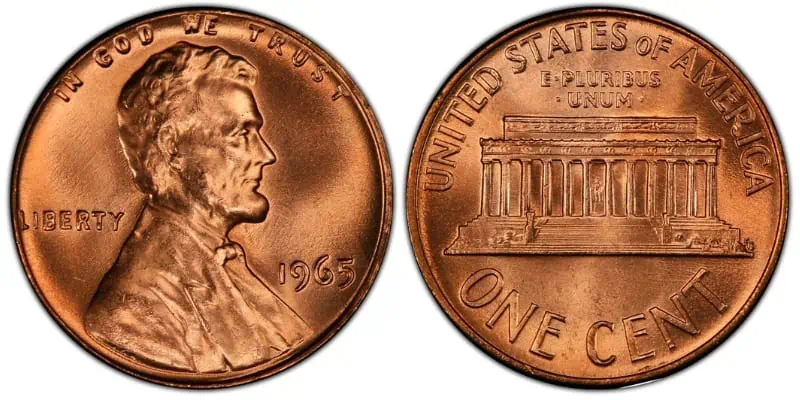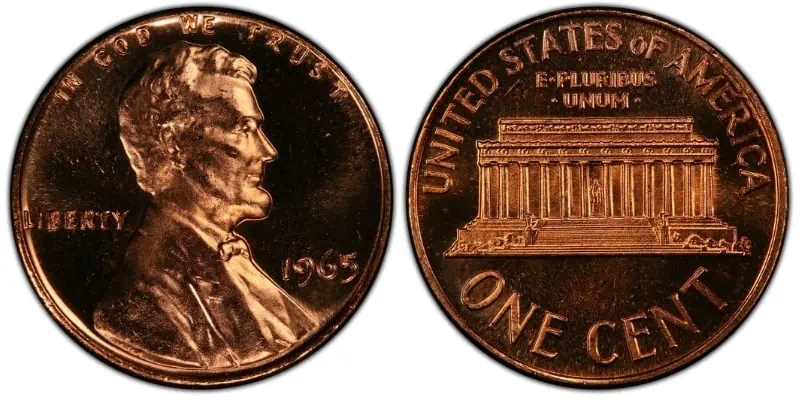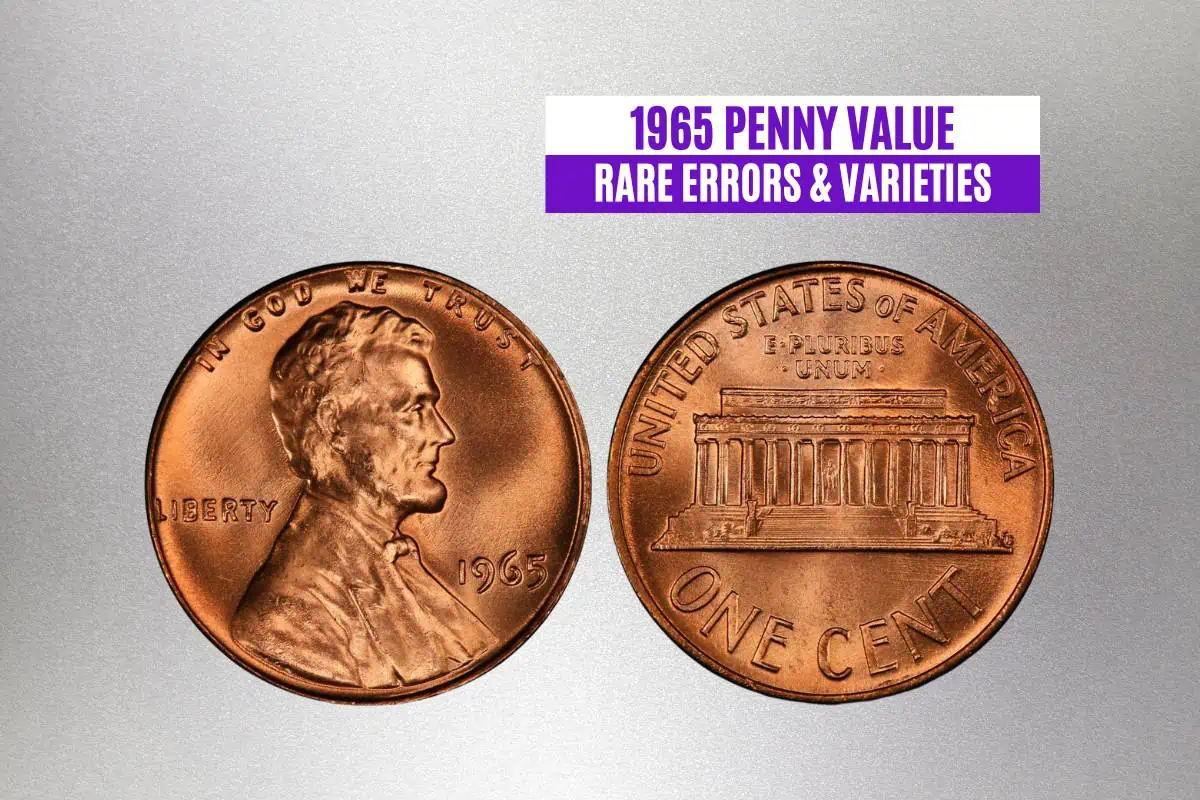Are you a coin collector wanting to know how much a 1965 Lincoln Memorial penny is worth? If so, this guide will offer the insight and information you need!
The 1965 penny value is determined by condition, coloration, and strike type (regular or special mint).
Whether you already have this coin in your collection or want to add one, you can use this guide to discover just how much a 1965 Lincoln Memorial penny is worth. That way, you can sell or buy one of these pennies for the best possible, market-accurate price.
1965 Lincoln Memorial Penny Value Chart
| Variety | MS/SP-65 | MS/SP-66 | MS/SP-67 |
| 1965 Penny BN | $2.5 | $5 | $7.5 |
| 1965 Penny RB | $7.5 | $20 | / |
| 1965 Penny RD | $15 | $25 | $175 |
| 1965 SMS Penny RD | $3 | $6 | $30 |
| 1965 SMS Penny RDC | $180 | $550 | $1,000 |
| 1965 SMS Penny RDU | / | / | $4,000 |
1965 Lincoln Memorial Penny: History
Without the 1959 Lincoln Memorial cent, the 1965 Lincoln penny probably wouldn’t exist! That’s because the design for the 1965 Lincoln Memorial penny was adopted in 1959, replacing the Lincoln Wheat (or Wheat Reverse) penny.
But a few changes implemented between 1959 and 1965 make the 1965 Lincoln Memorial penny a unique coin. For example, in 1962, the U.S. Mint stopped producing pennies made of tin, opting to create zinc-and-copper-only coins instead. As such, 1965 Lincoln Memorial pennies are 95% copper and 5% zinc (as opposed to 5% tin and zinc).
The Coinage Act of 1965 also played a role in making 1965 pennies historically significant. This act removed mint marks from pennies, making them far less collectible.
1965 Lincoln Memorial Penny: Design
All 1965 Lincoln Memorial pennies, regular strike and SMS versions, feature the Lincoln Memorial design. This design is one of the most recognizable aspects of 1965 pennies and was first implemented in 1959.
1965 Lincoln Memorial Penny Obverse

The obverse (front) side of the 1965 Lincoln Memorial penny features:
- The motto “IN GOD WE TRUST” on the upper portion of the coin, displayed in an arch that adheres to the coin’s natural curvature
- The raised image (device) of President Abraham Lincoln, his face in profile looking toward the right side of the coin, extending from beneath the motto “IN GOD WE TRUST” to the bottom curve of the coin
- The motto “LIBERTY” extending from the left side of the coin, just below the center, almost parallel with Lincoln’s neck and upper coat
- The year date (1965) on the lower right side of the coin, just below Lincoln’s bow tie
1965 Lincoln Memorial Penny Reverse

The reverse (back) side of the 1965 Lincoln Memorial penny features:
- The issuing country legend “UNITED STATES OF AMERICA” on the upper portion of the coin, arched to follow the coin’s curvature
- The motto “E PLURIBUS UNUM” separated by interpoints, just below “UNITED STATES OF AMERICA”
- The device (raised image) of the Lincoln Memorial in the center of the coin
- The denomination “ONE CENT” along the bottom part of the coin
1965 Lincoln Memorial Penny: Specifications and Features
1965 Lincoln Memorial pennies don’t only share a standard design (the Lincoln Memorial or Memorial Reverse design). They also share a few features, including:
- The absence of mint marks
- More copper than modern pennies
It’s also worth noting that there are no proof strike 1965 Lincoln Memorial pennies.
The Coinage Act of 1965 put in motion a few changes at the U.S. Mint to dissuade collectors from pulling pennies out of circulation, including preventing the production of proof pennies. However, the Special Mint Strike penny helped fill the place of the coveted proof strike coin.
No Mint Marks
A Lincoln penny’s mint mark (D, S) denotes where it was created, with each letter representing the location of the U.S. Mint facility where the penny was produced. Pennies struck at the Philadelphia Mint are typically the only Lincoln pennies that lack a mint mark.
But in 1965, all pennies lacked a mint mark. This continued until 1968, when mint marks were restored to pennies.
This change was done to make Lincoln Memorial pennies less collectible. After all, penny rarity is often based on mintage volume, and pennies that feature the mint mark of a low-production facility are generally more valuable.
Made of Mostly Copper
Nowadays, Lincoln pennies are made of copper-covered zinc. But in 1965, U.S. pennies were 95% copper! This makes them inherently more valuable than their listed denomination of $0.01.
Unfortunately, the high copper content of older pennies (those struck before 1982 and 1983) makes them slightly harder to find. Many people have melted these coins into pure copper alloy to sell them for a quick buck.
Official Launch of SMS Coins
Although there aren’t any proof strike pennies from 1965, 1966, and 1967, the U.S. Mint released a collector-friendly version via the Special Mint Strike set. This five-coin set consisted of the following:
- A Lincoln Memorial penny
- A Jefferson nickel
- A Roosevelt dime
- A Washington quarter
- A Kennedy half-dollar
SMS coin sets continued until 1967, with later releases (1966 and 1967) featuring higher-quality coins. Curiously, there are also a handful of 1964 SMS coins, even though the U.S. Mint didn’t officially begin producing SMS pieces until 1965.
How Much Is a 1965 Lincoln Memorial Penny Worth?
A circulated 1965 Lincoln Memorial penny in good (G-4) or about uncirculated (AU-50) condition has an estimated value of $0.05. One in uncirculated (mint state) condition can sell for between $0.10 (B.N., MS-60) and $175 (R.D., MS-67).
Notably, no 1965 pennies feature mint marks, so condition and coloration are significant factors influencing the value of these coins.
1965 Lincoln Memorial Penny: Value Comparison
While the mint mark on other Lincoln Memorial pennies influences their values, no pennies minted in 1965 have a mint mark. They were all produced at the Philadelphia Mint, which never strikes pennies with mint marks (except briefly in 2017).
So, to determine the value of a 1965 Lincoln Memorial penny, you’ll need to consider the following:
- Condition (PCGS or NGC grading)
- Coloration (brown, red and brown, or red)
- Type (Regular Strike or SMS)
Let’s quickly explore and compare the potential values of these one-cent coins to discover which are the most (and least) valuable examples.
1965 Lincoln Memorial Penny Value

The 1965 Lincoln Memorial penny (also called the 1965 “No Mint Mark” penny or the 1965 Regular Strike penny) is worth between $0.05 and $175. The most valuable 1965 Lincoln Memorial pennies are coins in exceptional condition (MS-64 or higher) that retain their like-new red coloration.
Brown
If you’re not a numismatist, you might think all pennies are brown! After all, the common in-circulation penny has a brown color that only darkens as it ages.
But pennies that are freshly minted have a much brighter red coloration. This coloration comes from the copper content (or covering, for pennies from 1982 onwards) of the coin.
As this copper oxidizes (mixes with oxygen in the air), it transforms from a red-orange hue into a dark brown color. Although this process is normal, it can significantly devalue a penny. Red pennies that are several decades old were likely owned by collectors who probably kept them in sealed containers, denoting an overall higher quality than heavily circulated pennies.
So, if you have a brown (B.N.) 1965 Lincoln Memorial penny, its value is much lower than the red and brown (R.B.) or red (R.D.) varieties.
A brown 1965 Lincoln Memorial penny in good (G-4) or about uncirculated (AU-50) condition has an estimated value of $0.05. One in-mint state (MS-60) condition is worth about $0.10, though higher mint state grades have higher values. For example, an MS-66 BN 1965 Lincoln Memorial penny is estimated at $5.
The most valuable B.N. 1965 Lincoln Memorial penny would be an MS-67 piece. These pennies are worth about $7.50, making them 150 times more valuable than their good-condition counterparts!
Red and Brown
Red and brown (R.B.) 1965 Lincoln Memorial pennies are almost always in mint state condition, as they’ve only slightly oxidized. This means that R.B. pennies primarily come from well-maintained collections and may have only been in circulation briefly.
The value of an R.B. 1965 Lincoln Memorial penny varies between $2.50 (MS-63) and $20 (MS-66).
Red
Red (R.D.) coins are typically the most valuable and sought-after type of Lincoln Memorial pennies, showing minor (if any) wear or oxidation. An R.D. 1965 Lincoln Memorial penny has an estimated value ranging between $5 (MS-63) and $175 (MS-67).
An MS-66 RD 1965 Lincoln Memorial penny is worth slightly more than its R.B. counterpart, estimated at $25. Still, the regular strike (for-circulation) 1965 Lincoln Memorial penny is generally worth far less than 1965 Special Mint Strike (SMS) pennies.
1965 SMS Lincoln Memorial Penny Value

Officially, 1965 was the first year that the U.S. Mint produced Special Mint Strike (SMS) coins. Consequently, SMS coins from 1965 are considered highly collectible. They’re not only in better condition than most circulated coins but also historically significant.
Notably, the SMS coins of 1965 to 1967 are not proof coins. While they’re of higher quality than regular strike coins, they’re generally not as painstakingly perfect as proof specimens.
Still, SMS pennies (especially those from 1965) are often worth far more than standard regular strike coins, especially if they have a cameo finish.
Red
If you have a 1965 SMS Lincoln Memorial penny, there’s a good chance it’s red. After all, these coins were presented in special collector’s packets and weren’t designed for circulation, meaning most (but not all) don’t feature heavy oxidation.
The value for an R.D. 1965 SMS Lincoln Memorial penny varies between $3 (SP-65) and $30 (SP-67). Specimens in SP-66 condition have an estimated value of $6.
Red Cameo
Red SMS pennies with a cameo finish are often worth far more than non-cameo coins. A cameo finish is a shading change that produces an almost two-tone effect, with the coin’s field (background) being darker than its raised device (in this case, the profile of Abraham Lincoln).
An RD CAM SMS 1965 Lincoln Memorial penny in SP-65 condition is estimated at $180, while one in SP-66 condition is worth about $550. Still, RD CAM SMS pennies in SP-67 condition are worth the most out of all SMS cameo pennies from this year, with an estimated value of $1,000.
Red Deep Cameo
A deep cameo finish has a more dramatic tonal difference between the coin’s field (background) and raised portion (device). In most instances, the coin’s field is far darker than its device, which can almost look “frosted” due to its light coloration.
The most valuable 1965 Lincoln Memorial penny is the RD DCAM (or RDU) coin. This red, deep cameo penny is estimated at $4,000 (SP-67).
1965 Lincoln Memorial Penny: Rare Errors
The Philadelphia Mint facility struck more than a billion pennies in 1965. Most of these coins were error-free, but with a high production volume, it’s only natural that a few pennies would end up less than perfect.
Still, error pennies from 1965 are rare, as most facility staff spot and remove error coins before they enter circulation. So, if you find a 1965 Lincoln Memorial penny with an error, you might have a valuable coin on your hands!
Some examples of 1965 Lincoln Memorial penny errors include:
- The 1965 Lincoln Memorial Penny Clipped Planchet Error
- The 1965 Lincoln Memorial Penny Off-Center Error
- The 1965 Lincoln Memorial Penny BIE Die Crack Error
Each of these rare error coins has a unique value. Let’s explore each one to discover what makes them distinct and how much they might be worth.
1965 Lincoln Memorial Penny Clipped Planchet Error
The minting process of a U.S. coin is a multi-step operation that generally starts with planchets. A planchet is a small metal disc that’s smooth and plain, lacking any of the details that give a coin its iconic look.
Planchets are made of various materials, though in the case of 1965 Lincoln Memorial pennies, they’re made of 95% copper and 5% zinc.
Sometimes these planchets are disfigured during the blanking process (when coins are pressed into individual pieces), resulting in clipped-off edges that prevent coins from being perfectly round. Some pennies struck in 1965 feature the “clipped planchet” error, as seen by their missing rounded sides.
These coins can sell for higher prices than standard brown regular strike pennies, though their values vary depending on the severity of the clipping. 1965 Lincoln Memorial pennies with small clips often sell online for between $8 and $15.
1965 Lincoln Memorial Penny Off-Center Error
Before coins are “punched out” during the blanking part of the minting process, they’re pressed by coin dies, like metal stamps. These stamps give the coins their recognizable designs.
But when planchets are off-center during this part of the process, the designs may be off-center, leaving a significant part of the original metal planchet blank. Off-center error coins are often highly valuable, though they can be difficult to date when the year portion of the design is missing.
A 1965 Lincoln Memorial penny with an off-center error can sell for between $20 and $1,500. Double-struck off-center pennies tend to be the most valuable, and they feature significantly more design mistakes than more subtle off-center examples.
1965 Lincoln Memorial Penny BIE Die Crack Error
The coin dies used to give coins their designs aren’t infallible. Over time, these metal stamps develop cracks or wear out, resulting in lackluster coins with noticeable flaws.
For the 1965 Lincoln Memorial penny, one of the most noticeable die crack errors is the “BIE” die crack. This error is the result of one of the coin dies developing a noticeable crack in the motto “LIBERTY,” with the crack extending between the “B” and “E,” and the vertical die crack caused a little raised line that looks like a capital “I,” resulting in what looks like “BIE.”
These die-crack pennies can sell for up to $10 apiece, with high-quality coins (mint state grade) often selling for the highest prices.
Frequently Asked Questions
Do you have additional questions about the 1965 Lincoln Memorial penny? If so, check out these frequently asked questions. You might just find the answers you’re looking for.
Where Is the Mint Mark on a 1965 Penny?
No Lincoln Memorial pennies struck in 1965, 1966, and 1967 have mint marks. This lack of mint marks resulted from the Coinage Act of 1965, which discontinued mint marks to make coins less appealing to collectors. However, mint marks on pennies eventually returned in 1968.
Are There Any Proof 1965 Lincoln Memorial Pennies?
There are no proof 1965 Lincoln Memorial pennies. However, the U.S. Mint produced about 2.36 million Special Mint Strike (SMS) pennies in 1965, likely to ensure collectors had access to collectible coinage that wouldn’t impact the supply of in-circulation coins.
How Many 1965 Lincoln Memorial Pennies Exist?
The Philadelphia Mint produced over a billion pennies in 1965, so there’s a good chance that hundreds of millions of these coins are still in circulation (or present in private collections). However, because these coins contain such a comparatively high percentage of copper, many may have been melted down for their copper content, thus lowering the potential number still around today.
1965 Penny Value: Final Thoughts
When determining the 1965 penny value, it’s crucial to consider coin condition, coloration, and type (regular strike or SMS). These factors significantly impact a penny’s worth.
Brown regular strike pennies in good (G-4) condition are generally worth the least, with an estimated value of $0.05. Special Mint Strike 1965 pennies are worth far more, with Red Deep Cameo (or Red Ultra Cameo) pennies in exceptional condition (SP-67) having an estimated worth of about $4,000!
Discover more about the most valuable coins. Check out these related articles now!

